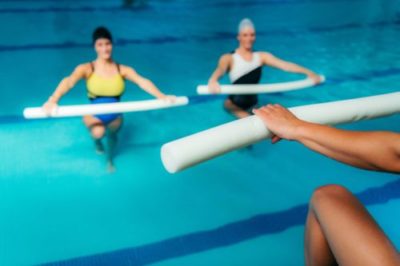By Christina DeBusk
Whether you’re looking for a way to stay in shape or trying to recover from some type of injury, working out in the pool or another body of water can help. This is because water exercises support health in a variety of ways. And they can target the areas of your body that you want (or need) to work on the most.
How Swimming and Water Exercises Support Better Health
“Exercising in a pool of water has numerous benefits,” says Robert A. Hayden, DC, PhD, FICC, an American Chiropractic Association (ACA) member who practices in Griffin, Ga.—especially if performed consistently. Among these benefits are:
- It doesn’t put as much pressure on the muscles and joints. The good thing about water is that it makes you more buoyant. This places less stress on the muscles and joints, which can be helpful if you have a chronic pain condition such as fibromyalgia, osteoporosis, or arthritis. It’s also better for people with muscle and joint injuries while being an effective option for those who may struggle with other forms of exercise, such as those with obesity.
 Improved muscle strength and tone. Because water is thicker than air, it forces the muscles to work harder. “This kind of exercise increases muscle strength and tone,” says Dr. Hayden. At the same time, it also helps keep tendons more lubricated and makes them looser.
Improved muscle strength and tone. Because water is thicker than air, it forces the muscles to work harder. “This kind of exercise increases muscle strength and tone,” says Dr. Hayden. At the same time, it also helps keep tendons more lubricated and makes them looser.- Better balance. Water not only forces muscles to work harder, but it also requires you to pay more attention to your coordination. “Over time, this improves balance and reduces the risk of falls,” says Dr. Hayden, “[which are] the number one cause of both fatal and nonfatal injury in people over 65 years of age.”
- Greater flexibility. Water’s resistance may even increase range of motion in your arms and legs. This means that you can move them more freely, giving you greater flexibility.
- Cardiovascular benefits. “As with any physical activity, particularly with the kind of resisted exercise experienced in a pool, there is significant cardiovascular effect,” says Dr. Hayden. “It will increase your heart rate and dilate blood vessels leading to your skeletal muscles. This will improve the strength of your heart as well as your peripheral circulation.”
- It’s comfortable. “Many seniors in my patient population have access to a heated pool,” shares Dr. Hayden. “Not only does this add comfort, but it also lets people have access to the pool year-round, even in those cold months of winter.”
Simple Water-Based Exercises for Your Upper Body, Lower Body, and Core
If you’d like to enjoy these types of benefits, here’s a few exercises that Dr. Hayden suggests adding to your water workout.
Warm-Up
Before you even get into the pool, it’s important to get your body ready. To start, stand with your feet about shoulder-width apart. Then turn your body to each side several times, touch your toes, lean backward, and do some deep knee bends. “If you have conditions that will not allow you to move this way, save them for when you were in the pool,” suggests Dr. Hayden.
You can also walk in shallow water that is no more than waist high. Go slow, keeping your hands at your side as you move. “This will begin increasing your heart rate and diverting blood flow to the muscles of the lower extremity and the postural muscles of your back,” says Dr. Hayden. Do this for five to 10 minutes.
Lower Body Exercises
To help strengthen or rehabilitate your lower body (legs, buttocks, and lower back), grip the edge of the pool and extend your arms to float. For flutter kicks, keep your legs straight out and kick them up and down separately, just as you do when swimming. A butterfly kick is similar to what a dolphin does and involves keeping your legs and feet together, kicking them up and down at the same time.
Start with 10 flutter kicks followed by 10 butterfly kicks. Add more of each type of kick until you can do three full sets.
Upper Body Exercises
Want to tone or rehab your arms, shoulders, and neck? For these exercises, you’ll need to get into water up to your shoulders. Standing with your hands at your sides, raise your arms with your palms up against the resistance of the water. When your arms are level with your shoulders, turn the palms down and push down toward your hips. Repeat this 10 times.
Next, with your arms level with your shoulders and outstretched, turn your palms straight ahead of you and move your arms forward and backward as though you were a bird flying. Repeat this 10 times. “You should feel the muscles in your chest, shoulders, and neck fully engaged,” says Dr. Hayden.
Core Exercises
To work your midsection, stand so the edge of the pool is behind you. Reach back and hold onto it, then draw your knees to your chest before pushing yourself backward into the water and floating on your back.
When you stop moving, draw your knees back to your chest, then extend your feet to the bottom of the pool and walk back to the wall. Repeat this until you can do two or three sets of 10. “You will feel this in those muscles over your stomach that you would like to convert to a sixpack,” says Dr. Hayden.
Additional Tips for Pool Exercise Success
There are also a few things you can do to make your water-based exercise safer and more effective. They include:
- Get approval first. Before beginning a new exercise regimen or increasing the intensity of your current program, talk with your healthcare provider to make sure it is safe for you.
- Staying hydrated. “It is easy to forget that when we exercise, we sweat,” says Dr. Hayden. “So, stay hydrated. Drink plenty of water before, during, and after pool exercises.”
- Make sure the water isn’t too warm. “If you are in a heated pool, make sure the temperature is under 90 degrees,” suggests Dr. Hayden. This is because water that is too warm may negatively affect your circulation.
- Pay attention to your body. “If you feel lightheaded, dizzy, faint, weak, nauseated, or experience chest pain, get out of the water immediately and call for help,” stresses Dr. Hayden.
- Practice pool safety. Have a flotation device on you—particularly if you are getting into water above your waist. “Falling onto the ground or floor is bad enough if you are prone to falling,” says Dr. Hayden, “but falling underwater is a different proposition altogether. And don’t get in the pool alone. Have someone close by while you are exercising.”
Adding Chiropractic for Greater Musculoskeletal Health
Doing these exercises can help you boost your musculoskeletal health. So too can engaging in regular chiropractic care. Find a doctor of chiropractic in your local area and together you can create a plan for optimal health and wellness.



